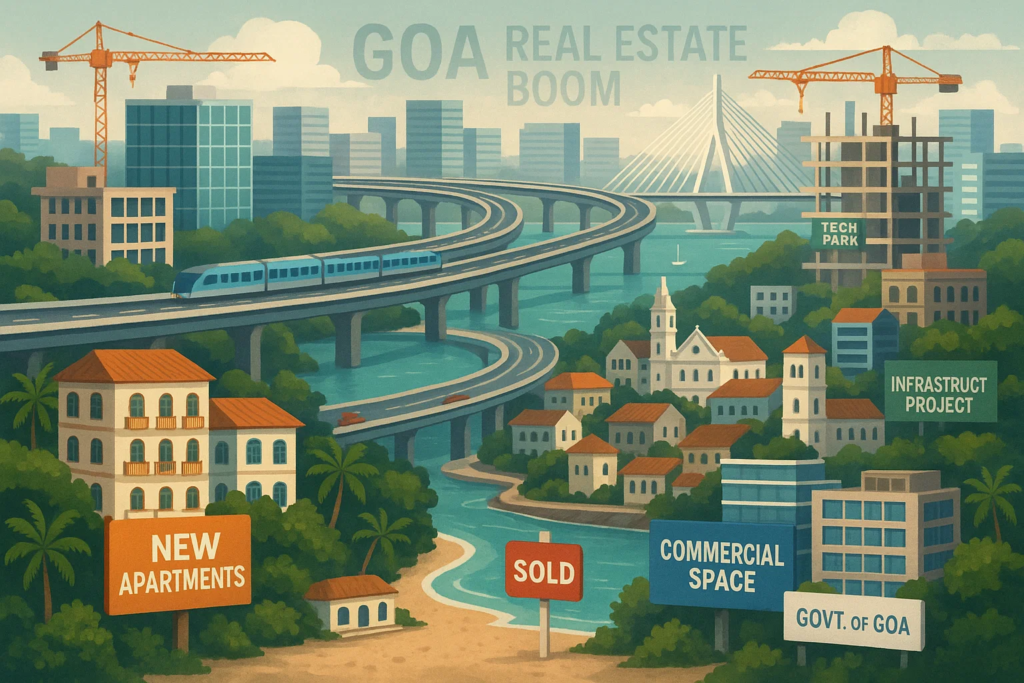Goa is no longer just a vacation destination. With major government initiatives rolling out across infrastructure, urban planning, and real estate policies, the state is evolving into one of India’s most promising property investment hubs. Whether it’s luxury villas, gated communities, or affordable housing, government-led development is now the key driver behind Goa’s booming property market.
Here’s a breakdown of how these changes are shaping the future of real estate in Goa.

Government Infrastructure Drives Real Estate Growth
The Goa government has prioritized infrastructure as the backbone of economic and real estate growth.
Mopa International Airport: A Game-Changer
The Manohar International Airport at Mopa, North Goa, has drastically improved national and international connectivity. Real estate activity around Mopa, Pernem, and surrounding coastal belts has surged, with increasing demand for vacation homes and rental properties.
Expressways and Road Networks
New expressways and upgraded highways connecting Goa to Maharashtra and Karnataka are reshaping investment patterns. The proposed Shaktipeeth Expressway is expected to turn Goa into a strategic node in India’s logistics corridor, bringing in commercial investments and boosting residential demand in inland areas.
Improved Intra-State Connectivity
Bridges like Atal Setu and rural road upgrades are making remote areas more accessible. This has led to increased land development and new property launches outside the traditional hotspots like Panaji or Margao.
Unlocking Land for Development
To meet rising demand, the state government is unlocking new land zones through strategic partnerships and planning reforms.
Public-Private Partnerships (PPP)
Unused or underutilized government land is being repurposed for residential and mixed-use developments. The Housing and Urban Development Boards have initiated collaborations with reputed private developers, leading to new projects in Vasco, Porvorim, and Mapusa.
Redevelopment of Orchard and Community Lands
New policies allow for the redevelopment of orchard lands with owner participation. This not only increases land availability but also keeps locals invested in the real estate economy by sharing in the benefits.
Affordable Housing Gets a Push
While luxury villas and second homes dominate headlines, the government is focusing on inclusive growth.
Slum Redevelopment and Low-Cost Housing
Affordable housing projects are being initiated through land pooling and redevelopment of low-income zones. These provide formal housing for locals and migrant workers, and also reduce pressure on urban infrastructure.
Housing Subsidies and Reduced Approval Timelines
New schemes offer incentives and faster approvals for developers building budget housing. These include fee waivers, tax relaxations, and flexible zoning benefits, encouraging builders to invest in the affordable segment.
Heritage and Sustainability: The New Focus
Goa’s heritage and natural charm are key to its identity. The government is integrating these elements into urban planning.
Heritage Preservation Incentives
Owners of old Portuguese homes and other heritage properties are now eligible for conservation grants and technical support. This initiative not only protects the architectural character of Goa but also enhances real estate value in these heritage zones.
Environmental Regulations and Carrying Capacity Norms
New planning guidelines include limits on construction density based on the ecological capacity of areas. This ensures that popular regions don’t face overdevelopment and infrastructure breakdowns.
Real Estate Trends Emerging from Government Initiatives
These policy and development changes are already reshaping market behavior.
Shift from South to North and Hinterland Goa
Thanks to Mopa Airport and better roads, North Goa and interior regions are seeing more real estate activity. Areas like Mandrem, Pernem, and Bicholim are emerging as real estate hotspots.
Rise in Rental Yields and Property Appreciation
Improved connectivity and tourist inflow have pushed up both property prices and rental yields. Luxury homes and branded residences are seeing year-on-year price appreciation of 10–15% in prime areas.
Regularization of Informal Housing
The government is drafting new laws to bring informal and unregistered housing into the formal sector. This will create a more transparent and secure property environment, boosting buyer confidence.
Opportunities and Risks for Buyers and Investors
While the outlook is optimistic, there are challenges to navigate.
Opportunities:
- Early investment in new growth zones like Pernem or Bicholim
- High rental returns from vacation and holiday rentals
- Increased transparency and planning discipline
Risks:
- Price hikes could reduce affordability for local residents
- Ecological impact of large-scale developments must be managed
- Over-reliance on tourism may affect long-term housing demand stability
Goa is Changing—and So is Its Real Estate Future
From a laid-back holiday destination to a dynamic property market driven by planned government interventions, Goa is undergoing a real estate revolution. Infrastructure development, policy reforms, and sustainable urban planning are laying the foundation for a future-ready Goa.
For investors, this is a once-in-a-decade opportunity. For residents, it promises better living standards, more housing options, and improved city planning. The key now lies in balancing growth with sustainability—ensuring that development strengthens, rather than dilutes, Goa’s unique identity.